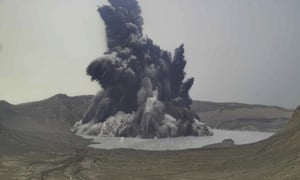
Aaron Favila and Joeal Calupitan have been reporting for Associated Press on the situation in the Philippines where thousands of people were being evacuated from villages around a rumbling volcano near the capital, but officials said they faced another dilemma of ensuring emergency shelters will not turn into centres of Covid transmission.
The alert was raised to three on a five-level scale after Taal Volcano blasted a dark gray plume into the sky yesterday. The five-minute steam- and gas-driven explosion was followed by four smaller emissions but the volcano was generally calm so far today, volcanologists said.

The preemptive evacuations involved residents in five high-risk villages in the lakeside towns of Laurel and Agoncillo. More than 14,000 people may have to be moved temporarily away from the volcano, said Mark Timbal, a spokesman for the government’s disaster-response agency.
Town officials, however, faced an extra predicament of ensuring emergency shelters, usually school buildings, basketball gymnasiums and even church grounds, would not become coronavirus hotspots. Displaced villagers were asked to wear face masks and were sheltered in tents set safely apart, requiring considerably more space than in pre-pandemic times.
In Laurel town, Imelda Reyes feared for her and her family’s safety in their home near the volcano and in the crowded grade school-turned-evacuation center where they took shelter Friday. “If we stay home, the volcano can explode anytime,” Reyes told AP. “But here, just one sick person can infect all of us. Both are dangerous choices.”
Most evacuation camps have set up isolation areas in case anyone began showing Covid symptoms.
“It’s doubly difficult now. Before, we just asked people to rush to the evacuation centres and squeeze themselves in as much as possible,” said disaster-response officer Junfrance De Villa of Agoncillo town.
“Now, we have to keep a close eye on the numbers. We’re doing everything to avoid congestion,” De Villa told AP by telephone.


